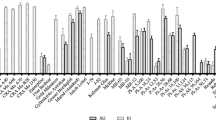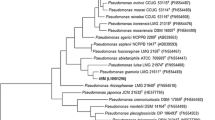Abstract
Host plants of Erwinia amylovora in the Royal Botanic Gardens of Melbourne (RBGM) and the Adelaide Botanic Gardens (ABG) were inspected for symptoms of fire blight including dieback, and shoot and stem cankers. Forty five symptomatic plants were sampled and concurrently tested for the presence of E. amylovora at the Institute for Horticultural Development, Victoria; Macquarie University, New South Wales; and the Max Planck Institute, Germany. At Max Planck, E. amylovora was isolated from wood samples from a Cotoneaster (Ag0002) and a Sorbus sorbus (Ag0034) from RBGM, and from a soft agar culture of bacteria isolated in Australia from Ag0002 and forwarded to Germany. Wood samples from ABG tested negative. Identification was confirmed by tests on selective media, by polymerase chain reaction assays, and by reactions on tobacco, pear slices and juvenile apple plants. The patterns obtained by pulsed field gel electrophoresis of the strains isolated from Australian samples in Germany and New Zealand were identical with each other and with strains of E. amylovora from Central Europe, New Zealand and with the English standard strain Ea595. However, the German and New Zealand strains of E. amylovora isolated from Australian wood samples differed in the size of the short DNA sequence repeat within the amplified plasmid pEA29 fragment. Exhaustive attempts in both Australian laboratories to isolate E. amylovora by similar test protocols from wood samples from RBGM and ABG were unsuccessful. Extensive surveys since the original outbreak have not detected the disease or the pathogen.
Similar content being viewed by others

References
Bereswill, S., Bugert, P., Bruchmuller, I. and Geider, K. (1995) — Identification of Erwinia amylovora by PCR with chromosomal DNA. Applied and Environmental Microbiology 61: 2636–2642.
Bereswill, S., Jock, S., Aldridge, P., Janse, J.D. and Geider, K. (1997) — Molecular characterisation of natural Erwinia amylovora strains deficient in levan synthesis. Physiological and Molecular Plant Pathology 51: 215–225.
Bereswill, S., Jock, S., Bellemann, P. and Geider, K. (1998) — Identification of Erwinia amylovora by growth in the presence of copper sulfate and by capsule staining with lectin. Plant Disease 82: 158–164.
Bereswill, S., Pahl, A., Bellemann, P., Zeller, W. and Geider, K. (1992) — Sensitive and species-specific detection of Erwinia amylovora by PCR-analysis. Applied and Environmental Microbiology 58: 3522–3526.
Campbell, J.A. (1920) — The Orchard; The outbreak of fire blight. New Zealand Journal of Agriculture 20: 181–182
Crosse, J.E. and Goodman, R.N. (1973) — A selective medium for and a definitive colony characteristic of Erwinia amylovora. Phytopathology 63: 1425–1426.
Dye, D.W. (1968) — A taxonomic study of the genus Erwinia. I. The Amylovora group. New Zealand Journal of Science 11: 590–607.
Guilford, P. J., Taylor, R. K., Clark, R.G., Hale, C.N. and Forster, R.L. (1996) — PCR-based techniques for the detection of Erwinia amylovora. Acta Horticulturae 411: 53–56.
Hugh, R. and Leifson, E. (1953) — The taxonomic significance of fermentative versus oxidative metabolism of carbohydrates by various Gram-negative bacteria. Journal of Bacteriology 66: 24.
Ishimaru, C. and Klos, E.J. (1984) — A new medium for detecting Erwinia amylovora and its use in epidemiological studies. Phytopathology 74: 1342–1345.
Jock, S., Kim, W.-S., Geider, K., Rodoni, B, and Merriman P. (1999a) — Isolation and characterization of Erwinia amylovora from Australian wood samples. International Workshop on Fire Blight 1998. Acta Horticulturae 489: 61–64.
Jock, S., Kim, W.-S., Rodoni, B., Merriman, P. and Geider, K. (1999b) — Fire blight in Australia? Proceedings of the International Symposium in Aschersleben, Germany 1998. “New aspects of Resistance Research on Cultivated Plants, Bacterial Diseases”. Beiträge zur Züchtungsforschung — Bundesanstalt für Züchtungsforschung an Kulturpflanzen 5: 19–21.
Kim, W.-S. and Geider, K. (1999) — Analysis of variable short-sequence DNA repeats on the 29 kb plasmid of Erwinia amylovora strains. European Journal of Plant Pathology 105: 703–713.
King, E.O., Ward, M.K. and Raney, D.E. (1954) — Two simple media for the demonstration of pyocyanin and fluorescin. Journal of Laboratory and Clinical Medicine 44: 301–307.
Klement, Z. and Goodman, R. N. (1967) — The hypersensitive reaction to infection by bacterial plant pathogens. Annual Reviews in Phytopathology 5: 17–44.
Leconte, P., Manceau, C., Paulin, J.-P. and Keck, M. (1997) — Identification by PCR analysis on plasmid pEA29 of isolates of Erwinia amylovora responsible for an outbreak in Central Europe. European Journal of Plant Pathology 103: 91–98.
McManus, P.S. and Jones, A.L. (1995) — Detection of Erwinia amylovora by nested PCR and PCR-Dot-Blot and Reverse-Blot hybridisations. Phytopathology 85: 518–623.
Merriman, P. (1 996) — Contingency plans for fire blight on pears in the Goulburn Valley and other pome fruit districts. HRDC Project No. AP 415.
Merriman, P., Rodoni, B., Gardner, R., Giles, R. and Kinsella, M. (1999) — Lessons learnt from the fire blight incident and update on the current situation. Proceedings from the Australasian Plant Pathology Society 12th Biennial Conference, Canberra, p. 188.
Miller, T.D. and Schroth, M.N. (1972) — Monitoring the epiphytic population of Erwinia amylovora on pear with a selective medium. Phytopathology 62: 1175–1182.
Paulin, J.-P. (1997) — Fire blight: Epidemiology and control (1921–1996) Nachrichtenblatt des Deutschen Pflanzenschutzdienstes 49: 116–125.
Rodoni, B., Kinsella, M., Gardner, R., Merriman, P., Gillings, M. and Geider, K. (1999) — Detection of Erwinia amylovora, the causal agent of fire blight, in the Royal Botanic Gardens, Melbourne, Australia. International Workshop on Fire Blight 1998. Acta Horticulturae 489: 169–170.
Schnabel, E. and Jones A. (1998) — Instability of apEA29 marker in Erwinia amylovora previously used for strain classification. Plant Disease 82: 1334–1336.
Taylor, R. and Hale, C. (1998) — Identification and characterisation of isolates of Erwinia amylovora from cotoneaster in Australia. Australasian Biotechnology 8: 353–355.
Van der Zwet, T. (1996) — Present worldwide distribution of fire blight. Acta Horticulturae 411: 7–8.
Van der Zwet, T. and Keil, H. (1979) — Fire blight: A bacterial disease of rosaceous plants. US Department of Agriculture, Agriculture Handbook No. 510.
Van der Zwet, T. and Walter, J. (1996) — Presence of Erwinia amylovora in apparently healthy nursery propagation material. Acta Horticulturae 411: 127–129.
Zhang, Y. and Geider, K. (1997) — Differentiation of Erwinia amylovora strains by pulsed-field gel electrophoresis. Applied and Environmental Microbiology 63: 4421–4426.
Zhang, Y., Merighi, M., Bazzi, C. and Geider K. (1998) — Genomic analysis by pulsed-field gel electrophoresis of Erwinia amylovora strains from the Mediterranean region including Italy. Journal of plant Pathology 80: 225–232.
Author information
Authors and Affiliations
Corresponding author
Rights and permissions
About this article
Cite this article
Jock, S., Rodoni, B., Gillings, M. et al. Screening of ornamental plants from the Botanic Gardens of Melbourne and Adelaide for the occurrence of Erwinia amylovora . Australasian Plant Pathology 29, 120–128 (2000). https://doi.org/10.1071/AP00020
Received:
Accepted:
Issue Date:
DOI: https://doi.org/10.1071/AP00020



